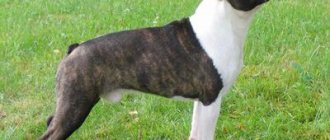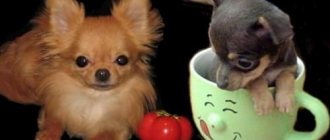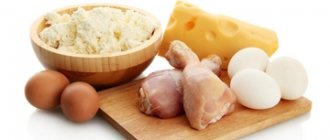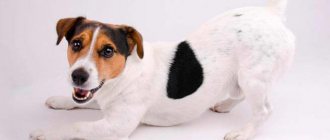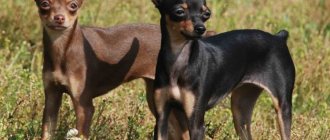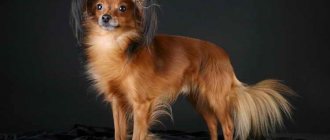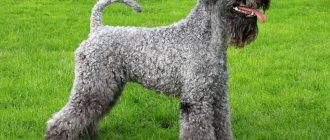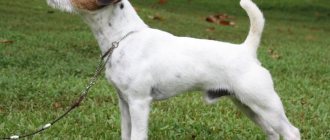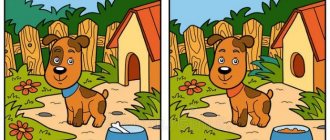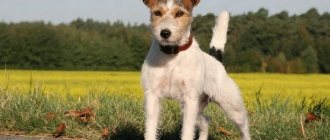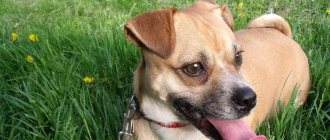Description and characteristics of the breed
The Australian Silky Terrier was once a brave hunter and today a friendly companion. Dogs of this breed have long and silky hair, which is why they got their name. Despite his small height and weight, Silky is a strong and fearless dog.
The Silkie bears a visual resemblance to the Yorkshire Terrier. However, the first impression is deceptive and noticeable only to those who are not very familiar with representatives of these two breeds. If York and Silkie are placed side by side, you will notice that they are not that much alike.
Please do not confuse the Silkie and Yorkshire Terrier breeds. They have only related roots, since Yorkies participated in the development of a new breed.
According to the breed description, the Australian Silky Terrier can show its full potential as a small guard dog. He is prescribed the following characteristics:
- Adapts well to the environment.
- Has high trainability and obedience.
- He requires an active lifestyle and moderate physical activity. These traits in the Australian Silky Terrier are derived from hunting Wirehaired Terriers.
- It has compact dimensions, an elegant body structure and strong bones.
- Capable of hunting small rodents and even snakes.
Origin and history of the breed
The breed originated in Australia in the early 19th century. At this time, the first Yorkshire terriers flooded the continent. As a result of their crossing with local species of terriers, a new breed appeared - the Silky Terrier. The breeders' goal was to improve the appearance of wool. As a result, it turned out silky, with a silvery-bluish tint. Cynological organizations appreciated the new breed. At the beginning of the 20th century, snares began to appear at world exhibitions.
During the short century of its existence, the Australian changed its standards several times. At the beginning of the 20th century, there were several of them (Sydney and Victorian), and they differed from each other. The situation was resolved in 1926, when a general standard was approved. But its final adoption occurred in 1959.
The breed spread to America after World War 2, when the American military began to import it to their continent. In the States, snares began to quickly gain popularity. And by the end of the 50s, the breed was recognized by cynological organizations in the country.
Exhibition standard
The breed standard received registration in the FCI standard under number No. 236 on December 5, 2012. Group of terriers, without working tests. The main purpose of the Australian Silky Terrier is as a companion dog. According to the standard he has:
- The head is of medium length, strong. It is covered with long, silky hair.
- The skull is moderately wide, not convex.
- The border between the bridge of the nose and the frontal part is moderately expressed.
- The muzzle is slightly narrowed.
- The nose is black.
- The lips are close-fitting, thin, black.
- The eyes are oval-shaped, small, dark in color. The expression of the eyes is intelligent and alert.
- The jaws are strong.
- The teeth are even, straight, scissor bite.
- The ears are triangular in shape, not large in relation to the head, erect, set high.
- The ends of the ears are sharp, the cartilage is thin.
- The neck is short, with a slight bend.
- The body is proportional, slightly elongated.
- The back is straight, the lumbar region is strong.
- The chest is deep, of medium width, convex ribs.
- The tail is in a vertical position, set high. May be cropped.
- The forelimbs are graceful and straight.
- The front and rear paws are compressed into a ball, dark in color, similar to a cat’s paw.
- The claws are black and strong.
- Hips are developed.
- The hock joints have a pronounced vertical angle, parallel to each other.
- The coat is flowing, pleasant and silky to the touch. The length of the fur on the limbs is shorter than on the body. The undercoat is soft.
- The coat color has all shades of blue with red tan, the more saturated the base color, the better.
A deviation from the standard is any discrepancy: high paws, shortened body, bulging eyes, hard coat, black or too light coat color, drooping ears, ring tail, hunchback, short muzzle, malocclusion and other defects.
Description of the Silky Terrier
The dog's build is strong and dense, its legs are short. The movements of the snare are light, free and energetic. The breed belongs to the group of toy terriers, the main purpose is to be a companion.
Size
The height of the terrier at the withers is from 23 to 26 cm (males are larger). The dog's weight is 3.5-4.5 kg.
Head
The snare's skull is wedge-shaped (the length of the upper part of the head is longer than the muzzle), and is of medium size. Slightly flattened on top, the distance between the dog’s wedge-shaped erect ears is small (but there is a fold-eared variety).
The terrier's eyes are almond-shaped, small, dark. The look is attentive, piercing. The edges of the eyelids and nose are black. The transition to the forehead is moderate. The teeth of the snare are in line and have a scissor bite.
Body type
The dog's neck is medium, the scruff is pronounced. The topline is level. The chest is wide and deep. The terrier's body is moderately low and elongated. The tail is docked. Major defects are considered to be a dog's back curvature and short body.
Limbs
Straight, strong, moderately muscular. The angles of articulation of the elbows and knees are pronounced. The breed's paws are small and compact, with the toes pointing forward. The pads are elastic and thick.
Color
Blue, blue, with thick tan. Too light colors in the breed are unacceptable. The color starts from the scruff of the neck and extends to the tip of the tail, down to the elbows and knees of the dog.
Wool
Long, flowing, parted in the middle of the back. The axial hair is not hard, there is a soft undercoat. The hair is smooth to the touch. Shorter on the limbs.
Difference from the Australian Terrier
The Silky Terrier differs from the regular Australian Terrier primarily in the quality of its coat. The terrier has a hard coat, 6 cm long, and also has a hard undercoat. The weight of terriers reaches 6.5 kg, and the height is 25 cm. The silky terrier has a coat that is almost floor-length, soft, flowing, and its dimensions will be smaller.
There are differences in both character and behavior. Australian terriers are still used as working hunting dogs, but their silky brother quickly took a place on the owner's soft pillows and is a luxury item at social functions.
Content and education
After the puppy is brought to its new home, a comfortable bed is provided for it in a quiet place. You definitely need to buy bowls for food and water, a leash and a comfortable harness, a variety of toys, and a high-quality tray.
You should start training a terrier from the age of two months, teaching him:
- relieve yourself in a tray;
- walk on a leash or harness;
- know your own nickname;
- distinguish between the owner and strangers.
The puppy is easy to socialize if you treat him kindly and reward him for the slightest success. Silks can be trained quickly and are distinguished by excellent memory and intelligence. To prevent the animal from getting tired and stubborn, you need to alternate games and educational moments. The dog needs an authoritative owner because it is willful.
This dog is a hunter, so during training it can be distracted by birds, a cat, dig a hole and attack the trail of small predators. If a terrier meets a relative, he will try to become an authority for him. When an Australian terrier is kept indoors for a long time, he begins to constantly get sick, his psyche is disturbed and aggressiveness appears. You need to walk with him for a very long time, introducing active games in the park into your walks. It would be ideal to have a terrier in a house with a garden plot surrounded by a high fence, since the dog loves to dig deep ditches.
Care
It is easy to care for the animal because it does not require care. To keep your snare healthy, beautiful and bright, you should:
- examine ears, teeth, eyes every day;
- periodically trim sharp claws;
- care for skin and coat;
- in rainy weather, wear overalls made of waterproof fabric on your pet.
Check the terrier's eyes daily for the presence of hairballs by treating them with wet cotton wool. Lubricate the ears weekly with oil, and clean the teeth with cleaning sticks. If the animal is already 10 years old, it may develop tartar on its teeth.
The word “silk” means silk, so caring for the dog’s coat is mandatory. In order for the Australian Terrier's coat to shimmer in the sun, it is necessary to bathe it once every 90 days using special shampoos. To properly care for the integument, you need to scratch it with a massage brush and trim it periodically. A dog can get sick from a draft, so it is important to wipe it off immediately after water treatments.
Training
From two months old, a terrier from Australia is capable of training, although the owner will have to overcome the dog’s innate stubbornness. It is strictly forbidden to let your pet off the leash until he learns the command “Come to me!” and "You can't." You should not hit or harshly punish the dog, so as not to cause aggressiveness. The Australian Terrier has proven itself excellent in agility; it is able to persistently pass the most difficult obstacle courses thanks to its agility and energy.
In order to interact correctly with your pet, you should teach it the commands of a general training course early. If a dog knows how to lie down and sit, move around and stand on command, its behavior can be controlled and protected.
Nutrition
A two-month-old puppy should receive food 5 times daily, but it is offered in small portions. From three months of age, you can put fish in a bowl, but only sea fish, and after a month you can add liver, kidneys, tripe and other offal. At this time, one feeding can be removed by increasing the portion and adding minerals or vitamins to the diet. At the age of six months, the puppy eats three times a day, he already becomes an adult and is actively growing. From the age of one year, the terrier eats 2 times a day: in the morning he is given light food, and in the evening he is given more high-calorie food (meat, cereal).
To balance your pet’s diet, you should feed it with ready-made super and premium class food for active small dogs.
If the owner has a little time, the snares are fed with natural products, but only of excellent quality. It is strictly forbidden to feed your companions fatty, smoked and pickled foods. You cannot include sweets, chocolates, potatoes in any form, baked goods, bird bones, or scraps from the common table on the menu.
Character and psychological portrait
The Silky Terrier has an active and energetic character. The psychological makeup of his mind can be classified as choleric. Silks are distinguished by the following character traits:
- curiosity, sticks his nose in wherever possible;
- courage, readiness to defend the owner;
- attachment to family;
- bored alone;
- loves children and does not show aggression towards them;
- loves active games in the fresh air with a ball or stick;
- requires vigorous walking, and in its absence can create a mess at home;
- performs the role of a companion with a plus.
Exterior
In the show ring, the snare is a beautiful sight, especially due to its blue and tan color and soft, shiny, silky coat. He is quick in his movements, dexterous, fearless, being a real terrier of his – Australian – type. Silkie does not pretend to be analogous to the Yorkshire, nor does he have the appearance of his cousin - the larger and stronger Australian terrier. Silky is quite compact, anatomically correct and leaves the impression of breed from head to paws. At the same time, a snilie is not intended to be only a show dog, when raising, caring, feeding, and walking - everything is subordinated to shining in the rings. Silky feels great without this fuss and strict regime - he is a wonderful companion and a family favorite.
The Silky Terrier's build must be balanced and in proper proportion to its height. The dog is quite bony, but its skeleton is not overdeveloped. The small body gives the impression of strength. Despite its refined build, it is primarily a terrier and only slightly a decorative dog.
The body of the snare is of medium length, noticeably longer than that of the Yorkshire. General appearance, height and build - a single harmonious whole, dressed in exquisite wool - both in color and texture.
The head of the snare is somewhat shorter than that of the Australian terrier. The muzzle is shorter than the skull, but despite this the strength of the jaws should be felt. The ears are erect and covered with short hair. Under the eyes, the snare's head is not as full as that of the Australian Terrier. There should be no long hair on the cheekbones and muzzle. The same is provided for Yorkshire. The soft, silky tuft on the head is lighter than the hair on the body as a whole; it should not fall into the eyes.
The muzzle is of sufficient width and depth for the dog to be able to grasp. This requirement differs significantly from the head requirements of other toy breeds. The eyes are expressive, shiny, with an attentive gaze. The neck is covered with thick hair of moderate length - such as not to hinder movement.
The body of the snare is noticeably different from the Yorkshire. In relation to the height at the withers, the body of the Silky Terrier is of moderate length, while the Yorkie has a short back. This length of the snare body provides it with a small elongation index.
Medium-length limbs: Silky is neither overly squat nor long-legged. The top line from the withers to the base of the tail is straight and horizontal. Various crossings undertaken at different times have negatively affected the correct topline of the snare. Therefore, a perfectly straight top is not so common. The shoulders form a graceful line, but are strong, covered with well-developed muscles.
The forearms are straight, fairly bony, but not heavy, not overdeveloped, not thin. The hip area is strong and somewhat longer than that of the Yorkshire Terrier. The hind legs are muscular, strong, with good leverage, which ensures correct movement of the hind legs, intelligent strength and width of step. When viewed from the side, the heel bones are in a line that can be lowered from the ischial tuberosity. The tail is left high and carried straight, dotting the “i” in the entire exterior and giving the dog a finished appearance. The tail is docked at 2/3 (although some breeders leave it at 2/5). The color of the tail should be significantly darker than the hair on the body.
Beautiful shiny coat, soft and silky - one of the most attractive characteristics of the breed. It fits well to the body, is straight, the hair is parted from the back of the head to the base of the tail. The length of the coat is 13-15 cm. It should not exceed the established length - otherwise it will lead to color irregularities, or be shorter - this may give the impression of a hard type of coat, such as that of the Australian Terrier. The long coat extends down to the wrists and hocks. The hair on the pasterns, paws and paws is short. The “outfit” of the snare requires special care, but not as thorough and labor-intensive as that of other dwarf long-haired breeds. A well-groomed and well-combed snare has an impressive and dandy appearance. The coat covers the dog with a continuous cover from the back of the head to the base of the tail.
The color of the snare is always a separate issue. The standard says: "Blue and tan and blue-gray and tan, the richer the colors, the better." The standard does not provide black or silver. Puppies, as mentioned, are born black and tan, but have a blue tint. It indicates that later the color of an adult dog will be correct. If a dog at the age of 2 years has a black body color, then there is no hope for its change. If there is gray hair in the puppy's undercoat, it is very likely that the adult dog will have a silver color or some white hair in it.
The blue color begins at the base of the nape, is present behind the ears and extends to the base of the tail. There should be no admixture of red or dark hair in the blue color, and no dark spots or blackness on the tan.
Fawn, golden-chestnut color is located on the ear cartilages, on the muzzle, cheekbones, around the legs, below the knees and hocks, on the paws, under the tail. A thin fawn edging runs along the knee. The preferred color of the crest is silver, but can be silver-blue. The crest crowns the dog's head. Today in breeding work it is difficult to achieve a truly silver color - without an admixture of black hair. The standard does not say which color of the crest is considered incorrect. Only the required shade is indicated. They should assume this. There is an opinion that dogs with a black muzzle should be left in the breed, but this is rejected by experts, since such individuals violate the established harmony of color and coat in the breed, and the aesthetics of their holistic perception.
The modern snilky is slightly larger than the Yorkshire. There are requirements for proportions: a large head on a weak, fragile body is just as undesirable as the opposite ratio. All items must be in correct proportions to each other.
Movement is free, limbs are directed straight forward, without stiffness in the shoulders or elbows. The nature of the movements is typical for a terrier - fast, precise, dexterous, springy movements.
Wavy, curly, curly, shaggy, coarse or short coats are not acceptable. The fawn color should not be mixed with the color of the body. Other serious defects noted in snares: undersized or overgrown, incorrectly colored nose (any other color other than black, spotted), eyes or claws. Neck dewlap or short thick neck. Incorrect nature of movements. Roughness or excessive lightness of build are equally serious defects.
Character traits
The main feature of the Australian Silky Terrier breed is its coat. It sparkles in the sun and shimmers. Such a four-legged friend deserves ]the highest quality grooming[/anchor].
Despite his luxurious appearance, the Silkie Terrier has retained the call of his ancestors and can become a working dog. With proper upbringing and proper training, he can become a nanny for children, a shepherd for small-hoofed animals, a guard and a hunter of small fur-bearing animals and rodents. Such a dog is ready to work tirelessly for the benefit of people.
Otherwise, this is an ordinary dog from the toy terrier class; it is a companion and a wonderful, devoted friend.
Character
The Australian Silky Terrier is a friendly and energetic dog that enjoys lively walks and games. In general, it dismantles all the qualities of a terrier - vigilance, activity, courage, self-esteem. Silky becomes very attached to his owner, and the rest of the family is treated affectionately and friendly.
They get along well with children of any age, but they are still more interested in older children. The size of the Australian Terrier does not allow the Australian Terrier to be a guard of his pack, but thanks to his courage and vigilance, he will perfectly cope with the role of a guard and will definitely warn of a visit with a ringing bark. He is wary of strangers. The Australian Silky Terrier was initially perceived only as a decorative dog, but the hunting and territorial instinct of its ancestors periodically makes itself felt. If in the summer the dog goes to the summer cottage, then you can forget about moles and field mice.
Judging by the reviews of the owners, silky terriers have a wonderful character. They are cheerful, playful, cheerful. They quickly understand what is wanted from them and adapt to the character and lifestyle of the family. They always want to be close to the owner.
Silks are smart and very easy to train. Recent studies have shown that among 100 ornamental breeds they occupy an honorable 20th place in terms of learning ability. They can be very temperamental, they can be stubborn at home, they will bully big dogs on walks, but with proper upbringing they show humility and obedience. They love to be petted and receive praise.
Interesting photo
Interesting Facts
The Australian Silky Terrier is not the most popular breed. However, there are several interesting facts associated with it:
- The breed was originally called the Sydney Silky. The dog received its current name in 1955.
- The Silkie, Yorkshire Terrier and Australian Terrier were considered a single breed until 1929.
- In Evgeniy Abyzov’s film “The Understudy,” a snare girl named Sima starred. She also appeared in the series “Let's Wake Up Together” in the company of two other Australian Silky Terriers.
Who is this dog suitable for?
The breed is suitable for people leading an active lifestyle. Snares for those who respect walks in the fresh air. The Silky Terrier is an alternative breed for people who like Yorkies, Cairns or Scottish Terriers.
The Australian “baby” will give everyone a head start. Silky is ideal for keeping in a city apartment, as it practically does not shed. It doesn't take up much space.
But for homebodies, phlegmatic people or busy people, such a silky dog will be a burden; it is not suitable for elderly people either. There is no need to get one for those who do not have the money and time to care for the silky coat of a pet.
Care and maintenance of the silky terrier
The Silk Terrier can live in a yard or enclosure only in warm climates. A harsh winter is a serious test for such a baby.
The Australian Silky Terrier is best suited for living in an apartment. He does not require much space, he has no undercoat and seasonal shedding. And his hair does not emit the characteristic dog smell.
This dog loves active walks. It is not necessary to spend 3-4 hours on the street with him, it is more important to let him run around and play to his heart’s content. Then at home the snare will behave like a silk one.
Caring for an Australian Silky Terrier includes the usual hygiene procedures: cleaning ears and teeth, rubbing eyes, trimming nails.
Special attention – wool
The terrier's magnificent silky coat requires a lot of attention. It quickly becomes dirty and tangles form on it. However, snare lovers claim that the fur of their pets is much easier to care for than that of Yorkies.
The owner should wash and comb the dog at least once a week. To prevent your beauty from fading, you need to use a special shampoo and conditioner that suits your hair type. After washing, be sure to dry the coat with a hairdryer and comb it with a massage brush and then with a comb.
Breeders of the breed categorically do not recommend combing dirty or dry hair. To combat mats, you need to use zoospray. They spray the problem area with it, and then sort out the tangled fur with their hands.
Feeding
At first, the Silky Terrier puppy needs to be provided with the food that he is accustomed to in his parents' home. Switching to a new diet is a serious test for a baby. Consult the breeder what he recommends feeding the dog. After a month or a month and a half, when your dog has settled in, you can gradually change the menu. Experienced dog breeders do not recommend mixing dry food and natural food. Choose one thing.
Snares are suitable for premium ready-made food for small breeds. Pay attention to the composition, whether there are any obvious chemicals there, and whether this diet is suitable for a long-haired dog.
Don't forget about your drinking regime. With any type of feeding, fresh water should be available to the dog around the clock.
If you prefer natural feeding, resist the temptation and do not treat your terrier with food from your table. Sausages, smoked meats and sweets are extremely harmful for animals; you should not feed pork (in any form), legumes and starchy vegetables. Also avoid bones, especially tubular ones. They can injure the dog's gastrointestinal tract.
Approximately 30-40% of the diet should consist of cereals (buckwheat, oatmeal, rice and the like) with vegetables. It is advisable to minimize heat treatment. Steam the porridge, lightly boil or stew the vegetables.
The rest of the menu consists of protein products of animal origin: lean beef, lamb, turkey, offal, sea fish fillet, cottage cheese, boiled eggs. Give some seasonal fruits and berries as a vitamin supplement and treat.
Health and possible problems
In general, the Australian Silky Terrier can be considered a healthy breed. It is this feature that distinguishes him from the variety of dogs in the dwarf category. When properly bred, Silkies should not have genetic diseases.
Rare diseases
- Legg-Calvé-Perters disease, when blood flow to the head of the hip joint deteriorates and it begins to die. Symptoms of the disease appear before the age of 6 months. Treatment is only surgical.
- Dislocation of the kneecap. This problem is common to many dwarf dogs. In this case, the dog can lead a normal life or become disabled, it’s all a matter of chance.
- Diabetes mellitus, in this case the pet cannot be cured one hundred percent. He must be on insulin injections and a strict diet for the rest of his life.
- Pancreatitis. Pancreatic disease is most often acquired due to poor feeding.
- Trachea problem. The disease can manifest itself due to physical fatigue or excessive overload.
Don’t let the list of diseases scare you; if the puppy was purchased from healthy parents and is maintained properly, then it should be free from all adversity.
Health
The American Silky Terrier is distinguished by good health, provided it has a pure pedigree. The general well-being of the dog is also affected by care and proper nutrition. Despite this, silky snares tend to get sick, which is due to a genetic predisposition to certain diseases specific to this breed.
Diseases
Pathologies inherent in this breed:
- cold;
- premature tooth loss;
- dysplasia and deformation of the hip joints;
- epilepsy;
- diabetes;
- skin diseases.
If your pet feels unwell, immediately contact a veterinarian. They do not self-medicate. This can only cause harm.
Vaccinations
The first vaccination for a puppy is carried out at 2 months. Next, they adhere to the vaccination schedule outlined in the veterinary passport.
After the first vaccination, immunity is developed within 12 days. During this period, you should protect the puppy from the slightest risks: do not go for walks, minimize contact with other animals, create comfortable conditions. The next procedure is prescribed at six months of age, then at one year. In the future, a complex vaccine is administered annually.
Feeding options
You can feed your Silky Terrier premium or holistic dry food. Dry food is properly balanced and provides the dog’s body with useful substances. If desired, Silky can be fed natural food.
| Can | It is forbidden |
| Beef, chicken breast, turkey | Pork, lard, fat, sausages |
| Sea fish (fillet) | River fish |
| Beef by-products | Bird bones |
| Beef bones and cartilage | Sweet, flour, salty, smoked |
| Carrots, zucchini, pumpkin, broccoli | Cabbage, legumes, potatoes |
| Buckwheat and rice | Semolina and other cereals |
With a natural diet, you will need to add vitamin supplements and fish oil to your diet. It is highly undesirable to alternate natural and dry food.
How to choose a puppy
There are not so many official breeders in Europe, in particular Russia. It is not recommended to purchase a puppy from an unverified company. Before purchasing, you need to ask about the puppy’s diet and living conditions. Inquire about weight and height. If possible, evaluate the parents live and find out about their diseases.
After this, you can evaluate the puppy itself. He must meet breed standards, be clean, well-groomed and happy. If your pet is interested in you, then you can take it without hesitation, because trust and love cannot be bought with money.
The cost of the Australian Terrier is high due to the uniqueness of the species. The official price varies from 12,000 to 30,000 rubles. You should not save on a puppy, because this can affect his behavior and health.
Buying a dog is always a joy, because it becomes a full-fledged member of the family. The Australian Terrier is not only loyal to its owners, but also has a cheerful character. He will always be able to help in difficult times with joyful barking and wagging of his tail. Looking into his eyes once, it is impossible not to fall in love with his purity and sincerity.
Price for adults and puppies
The Silkie breed is a novelty for Russia. You can buy purebred Silky Terrier puppies in kennels of the Russian Federation, of which there are not so many. Little Silkie is similar to York and it is important not to make a mistake here.
When buying an Australian Silky Terrier puppy, bet on a trusted breeder; otherwise, you can buy a Yorkshire Terrier cross with just anyone.
If you are seriously thinking about buying a puppy of this rare breed, then know that the price is quite high, approximately 50 thousand rubles. Cheap offers for the sale of Silka are a hundred percent deception. Adult dogs are sold much cheaper than puppies. Taking this factor into account, an adult Silkie will cost you 25-30 thousand rubles.
Who is the dog suitable for?
It is better for calm, balanced people to have a terrier snare. This dog should not be beaten or offended. She may grow up to be cowardly and aggressive. At the same time, the owner should have enough time to regularly walk with her. Moreover, walks should be as active as possible. So a snare is unlikely to be suitable for older people.
This breed can be owned by families with children. But it is better that the children are already grown up. Despite its benevolence, a snare is unlikely to tolerate careless treatment or being pulled by the tail.
Advantages and disadvantages
The Australian Silky Terrier breed has many fans in its homeland. However, every coin has a downside. Let's look at the pros and cons of Silka.
| pros | Minuses |
| Beautiful exterior | Long hair is difficult to care for |
| Compact dimensions | Chases cats and birds |
| Gets along with children | Likes to dig the ground |
| Good companion | Barks frequently and loudly |
| Well trained | Overly active character |
| Friendly with all family members | High price |
| Adapts well to different living conditions | You can't cut your hair |
| Good health | |
| Longevity | |
| No smell | |
| Weak shedding |
You can walk Silky within the city limits only on a leash; due to his hunting instinct and cocky disposition, he can run away or die.
Education and training
Australian Silky Terriers have a typical temperament for this group of dogs. Long selection aimed at maintaining decorative qualities could not destroy their cheerful and positive character. Silks learned to live with a family, but remained independent hunters. This must be taken into account when choosing this breed of dog.
The future owner must be ready to start raising the puppy from the very first days. The baby evokes affection and a desire to indulge his whims, but you cannot give in to him.
The silky dog will quickly turn into a domestic tyrant if everyone allows him to. A poorly behaved terrier sleeps in his master's bed and eats from his table.
If you do not want to correct the shortcomings of upbringing, immediately accustom your pet to a routine. You need to start with the simplest commands and skills: accustom him to a nickname, place, walks. The first litter box for small snares may be a cat litter box or diaper.
Then learning more complex commands. Australian Silk Terriers are easy to train; from childhood they are prepared for performances in the show ring.
If the dog will not be shown, you can go through a general training course with it, of course, adjusted for its small size. Silks are excellent at mastering agility techniques; they love to run and are quite fast.
Small terriers will benefit from group training and activities at the dog park. Early socialization will help tame the snare's cocky temperament.
Vaccinations and susceptibility to disease
Australian Silk Terriers are vaccinated according to the standard schedule:
- 8-9 weeks – complex vaccine;
- 11-12 weeks – revaccination;
- 6-7 months (after the end of the teeth change) - rabies vaccination.
Subsequently, the puppy is vaccinated at 12 months, after which vaccinations are given every year.
Silky Terriers are a fairly healthy breed. However, dogs are prone to certain diseases:
- colds;
- dysplasia of the hip and elbow joints;
- dislocation of the kneecap;
- epilepsy;
- cataracts and progressive retinal atrophy;
- diabetes mellitus
Proper care and regular visits to the veterinarian minimize the risk of pathologies. On average, Australian Silk Terriers live 12-15 years.
Wool and its care
This breed will charm you with its long coat of light brown color with splashes of blue. It flows from the back and is usually 13–15 cm long.
The Silky Terrier looks like it needs a lot of grooming, but it actually doesn't. Regular brushing 2-3 times a week and bathing once a month will be enough for this long-haired cutie.
Tartar is quite common, so your dog needs to brush his teeth 2-3 times a week. This is enough to avoid infections, gum disease and bad breath.
This breed will charm you with its long hair
The Silky Terrier needs to have its nails trimmed regularly, just like any other dog. However, these dogs are so active that this procedure does not need to be performed as often. You will be required to monitor when the nails are growing too long and then trim them. If you don't know how to do this, take your dog to the vet or groomer.
Check your pet's ears once a month for redness, odor, or inflammation. You can wipe them with a cotton ball soaked in a pH-neutral ear cleaning solution.
If you regularly care for your pet from the first months of its life, you will not have problems when it grows up. Your dog will become accustomed to all these procedures and will behave quietly and calmly at the veterinarian or groomer. Use positive motivation when caring for your pet so that the neo will form positive associations. Just don't be stingy with treats and rewards for your puppy, and he'll love it!
